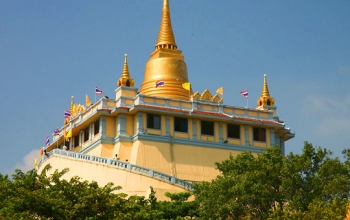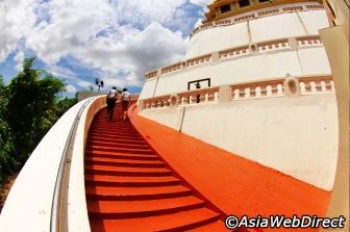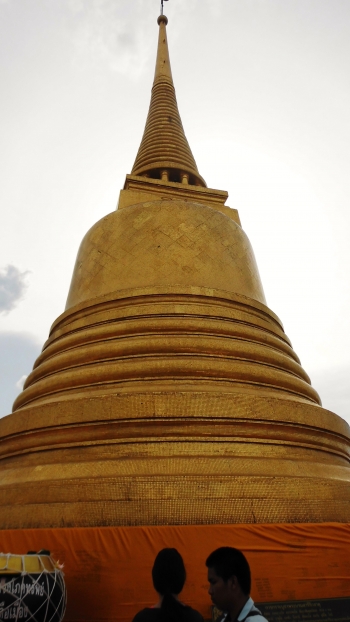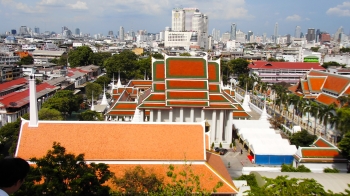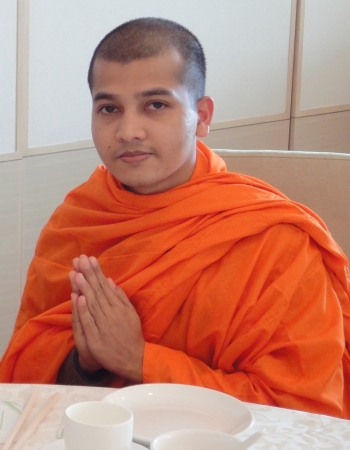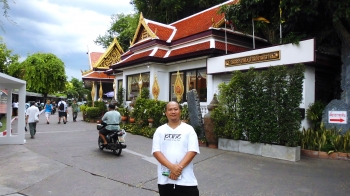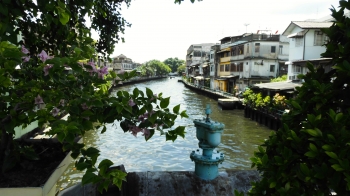As I climbed up the stairs leading towards the summit of Temple of the Golden Mount at Wat Saket on that hot sunny May morning of Vesak in Bangkok, my mind drifted back over what had brought me here. This would be my second Vesak celebration in 2014 as Vesak was held earlier, on 6 May, in Hong Kong.
Hong Kong society is so oppressively materialistic and secular in which all religious holidays have been mostly stripped of their spiritual essence (unless one is lucky enough to find a tiny refuge of truly devotional expression) leaving the individual to sink under the unceasing movement of the vast majority satisfying their craving. People are constantly shopping, indulging in entertainment or, for those interested in health, hiking or camping in country parks. Very little time is given to spiritual reflection. Of course, not everyone is a Buddhist so Vesak for most people is just another excuse for relaxation. (Unfortunately, this also happens with the two major events in Christian discourse of Christmas and Easter, a deplorable sign of modern times).
Undeterred by this unrelenting pressure of secularism, I decided to go to Bangkok for Vesak a week later because Thailand is predominantly a Buddhist country. I wanted to enjoy the atmosphere and witness some of the activities although I would be constrained by time. In addition, I wanted to get a clearer picture of the importance of Vesak to the two complementary pillars of Buddhism, the sangha and the laity, and how they interacted on this most important day. I would interview a monk and a layperson.
Venerable Dipa
Venerable Dipa was my classmate at the University of Hong Kong when I was reading for Master of Buddhist Studies in 2010. He is originally from the Chittagong Plains in Bangladesh and he went to Thailand after finishing his studies at the University of Hong Kong.
We caught up with each other at a coffee shop in the afternoon of 12 May, 2014. At the beginning he explained to me that for both members of the sangha and the laity, the importance of Vesak lies within its commemoration of three important events: the birth of the Buddha, his Enlightenment and Parinibbana.
For Ven. Dipa, the Buddha’s message is the most important. I asked him how we could better grasp and understand Buddha’s message. “By understanding the texts properly and through practice”. The first step is that we need to go back to the original suttas by ourselves or with the assistance of a good dhamma teacher to guide our understanding of what the Buddha has said. We also may need to refer to commentaries for a deeper awareness. Above all, Ven. Dipa said we need an inquiring mind when approaching the texts.
The second step after understanding texts at an intellectual level is practice. We need to apply whatever we learn in our daily lives and express the dhamma through thought, words and action. In response to my query on how to apply what we have learnt, Ven. Dipa said we could also consult dhamma masters whom I presume could be either lay or monastic. He went on to say that we must not generalise what we have read in the texts but be specific in our application in daily life.
I asked Ven. Dipa what he would do the next day on Vesak. He answered that he would return to Korat for chanting and meditation with fellow monks and students of International Buddhist College. He did not have much contact with local Thai lay people because he did not know Thai well enough to communicate. I had to wait for my second interview to find out more details about a monk’s interaction with the lay community on Vesak.
Since Ven. Dipa had also celebrated Vesak while he was in Hong Kong, my last question was about the difference he found between the two places. He said Hong Kong was too materialistic and Bangkok, although more materialistic than in the past, was more spiritual than Hong Kong because of the abundance of temples where many people congregated to worship the Buddha, wash the Buddha image, listen to Dhamma Talks, meditate and chant. However, he echoed a concern that people were becoming more mechanistic and ritualistic in their approach to Buddhism.
Prof. Utain
13 May was Vesak and I made my way to Wat Saket, a brisk 45 minute walk from the National Stadium, a small, quiet temple complex which I had last visited over 10 years ago. The walkway into the grounds was lined with many colourful stalls selling paraphernalia such as garlands of flowers, lotus buds, candles and incense for worshippers to use. The stall owners were poor people who lived on land owned by the temple.
The Temple of the Golden Mount is a manmade hill rising 260 feet behind the main vihara built in the 1800’s by King Mongkut. To reach the temple at its top devotees need to ascend 318 steps winding around the hill. I met Prof. Utain, a bubby, cheerful and constantly smiling academic who teaches in the Dept. of Oriental Languages, Archaeology Faculty at Silpakorn University, at the bottom of the stairs. We conducted our interview while visiting the Golden Mount.
Utain comes from a farming family in Ayutthaya, north of Bangkok, and followed a traditional path by pursuing his education through the local temple school, becoming a novice and later, a fully ordained monk. After getting his first degree in Philosophy he disrobed before going on to receive a Master in Oriental Languages and later in India, a PhD in Sanskrit. Wat Saket is also of personal interest to him because he spent five years here as a novice and fully ordained monk.
I asked Utain how he spent Vesak as a monk at Wat Saket and his interaction with the laity. Due to its significance, prior to Vesak, he was heavily involved helping the senior monks to organise the festivities. Vesak began early in the morning. At 0600 many people were stationed on the steps leading up the Temple Mount for alms giving. Throughout the day, in addition to the scheduled events of chanting at 0830/1700/2100, meditation and dhamma talks, Utain and other monks received visits from small groups of friends and family members. Monks and visitors engaged in conversation about problems and dhamma sharing.
In the afternoon the monks congregated together privately to recite the Patimokkha. In the evening around 1900 there was a candle Puja followed again by monks huddled in small group discussions with lay friends. Utain even had interfaith dialogue with his Christian friends who visited the temple.
Now as a layperson, Utain this year went home to Ayutthaya to go with his mother on a three day vipassana retreat. This morning, before returning to Bangkok to meet me, he participated in a special food offering with his father followed by a special candle Puja and Pali chanting.
He told me there is a difference between Bangkok and rural areas in food offering by the laity to the sangha. In Bangkok food was prepared (or, as I have done myself, purchased from street vendors) and put in alms bowls of monks who sometimes gave a blessing. In rural areas, food was prepared and taken to the temple. Sometimes monks were invited to homes for special chanting followed by a 30 minute Dhamma Talk.
As I was whisked away in his car under the darkening and threatening rain clouds, Utain mentioned the reason for the strength of Buddhism in Thailand came down to the fact that temples can be found everywhere without difficulty. Temples are the community’s heart and centre, providing activities in which everyone can join in. Monks are always there for consultation and spiritual guidance. Temples also play an important educational role, as in Utain’s own case.
I would like to participate in next year’s Vesak in a small town or, preferably, a village far away from the temptations and materialism of a large city.
